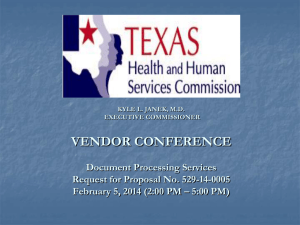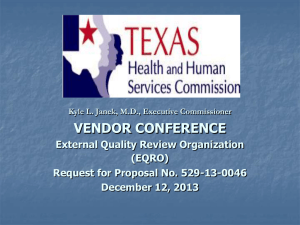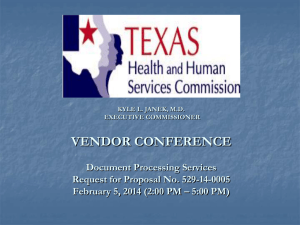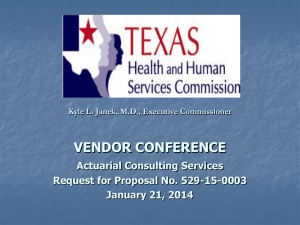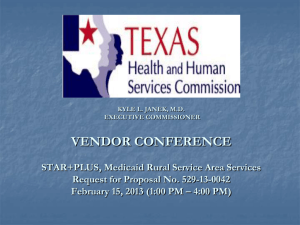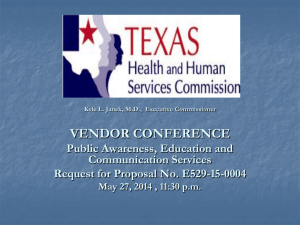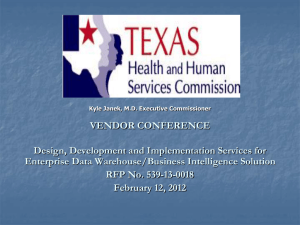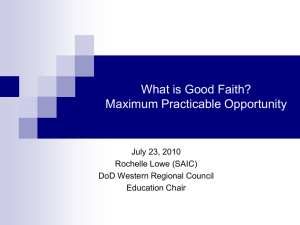Vendor Conference presentation
advertisement
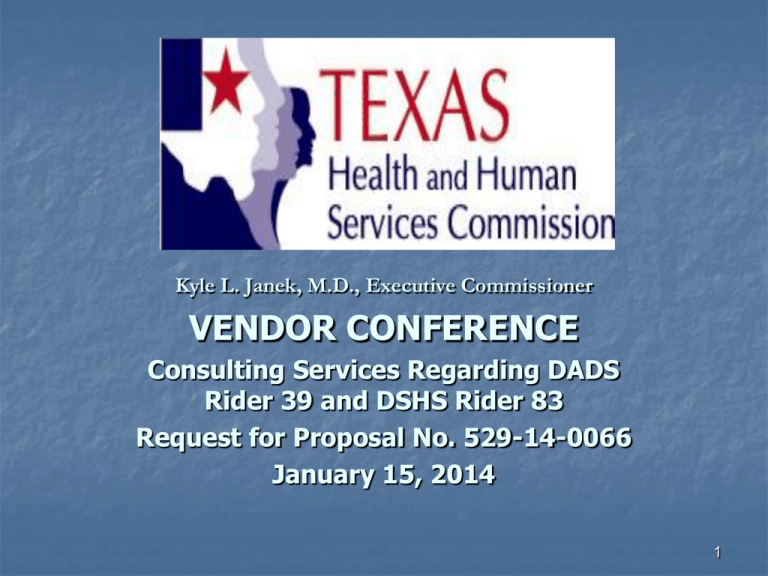
Kyle L. Janek, M.D., Executive Commissioner VENDOR CONFERENCE Consulting Services Regarding DADS Rider 39 and DSHS Rider 83 Request for Proposal No. 529-14-0066 January 15, 2014 1 Welcome Introductions Mike Labinski, HHSC Procurement and Contracting Services (PCS) Robert Hall, PCS Eugenia Andrew, Department of Aging and Disability Services (DADS) Mike Maples, Department of State Health Services (DSHS) Lachelle Greif, HHSC Facility Support Services & Oversight Meghan W. Frkuska, HHSC Legal Housekeeping Items 2 HHSC Procurement Roles PCS- Responsible for procurement activity HUB Program- Responsible for compliance with HUB Subcontracting Plan Programs (DADS and DSHS)- Responsible for project scope, requirements, performance, results, contract management/monitoring Legal- Questions/answers and legal activity 3 Vendor Conference Overview Procurement Activities HUB Subcontracting Plan RFP Overview Questions Break Preliminary Responses to Questions Closing 4 Procurement Activities Sole Point of Contact – Section 1.2 Procurement Schedule – Section 1.3 Solicitation Changes – Section 1.10 Solicitation Access http://www.hhsc.state.tx.us/about_hhsc/BusOpp/BO_opportunities.asp Submission Requirements – Sections 3.14, 3.15, & 4 Proposal Screening and Evaluation – Section 5.1 & 5.2 Award Information 5 Procurement Schedule RFP Release Date Vendor Conference Respondent Questions Due Post Response to Questions (est.) Proposals Due (3:00 PM Central Time) Deadline for Proposal Withdrawal Tentative Award Posting (est.) Anticipated Contract Start Date January 6, 2014 January 15, 2014 January 16, 2014 January 22, 2014 February 7, 2014 February 7, 2014 March 14, 2014 April 1, 2014 6 Historically Underutilized Business (HUB) Requirements Robert L. Hall Director, Enterprise Operations for Client Services Procurements / HHS HUB Coordinator, PCS 7 HUB Topics I. RFP Section 4.0 Historically Underutilized Business Participation Requirements II. HUB Subcontracting Plan Development and Submission III. HSP Quick Checklist – Handout IV. HSP Methods – Section 4.6.3-4.6.6 V. HSP Prime Contractor Progress Assessment Report – Section 4.8 8 I. Historically Underutilized Business Participation Requirements 9 I. RFP Section 4.0 Historically Underutilized Business Participation Requirements • HUB Participation Goals – Section 4.3 • Potential Subcontracting Opportunities – Section 4.5 • Centralized Master Bidders List and HUB Directory – Section 4.5 • Vendor Intends to Subcontract – Section 4.6 10 I. RFP Section 4.0 Historically Underutilized Business Participation Requirements (cont.) • Minority or Women Trade Organizations – Section 4.6.6 • Self Performance – Section 4.6.7 • HSP Changes After Contract Award – Section 4.8 • Reporting and Compliance with the HSP – Section 4.8 11 II. HUB Subcontracting Plan (HSP) Development and Submission 12 If HSP is inadequate, response will be rejected HUB GOALS Special reminders and instructions HSP Information Page 13 III. HSP Quick Checklist ** See Checklist Handout** 14 IV. HSP Methods 15 METHOD OPTIONS A Respondent may choose from one of the following methods when completing the HSP: • Method I – if 100% of your subcontracting opportunities will be performed using only HUB vendors; • Method II – if one or more of the subcontracting opportunities identified will be performed using HUB protégé’s; • Method III – if a combination of HUBs and Non-HUBs are used to perform the subcontracting work identified AND the HUB goal identified in the solicitation is met or exceeded; 16 METHOD OPTIONS A Respondent may choose from one of the following methods when completing the HSP (cont.): • Method IV – if a combination of HUBs and Non-HUBs are used to perform the subcontracting work identified AND the HUB goal identified in the solicitation is not met or exceeded. • Method V - if the Respondent intends to self perform all of the work utilizing their own resources, equipment, employees, and supplies. 17 ALL METHODS For ALL Methods the following steps are required to be completed on the HSP Form: • Page 1 - Section 1 - Respondent and Requisition Information; • Page 2 - Company and Requisition Information • Page 2 - Section 2(a) – Subcontracting Intentions • Section 4 – Affirmation and Sign 18 HSP Information Page Respondent and Requisition Information 19 Company Name and Requisition # Subcontracting Intentions: If Yes, Complete Section 2a If No, Complete Section 2b 20 Section 4; Affirmation Signature Affirms that Information Provided is True and Correct. 21 METHOD I If all (100%) of your subcontracting opportunities will be performed using only HUB vendors, complete: • All of the steps in Slides 19 and 20; • Section 2 b. – List all the portions of work you will subcontract, and indicate the percentage of the contract you expect to award to HUB vendors; • Section 2 c. – Yes; • HSP GFE Method A (Attachment A) – Complete this attachment for each subcontracting opportunity. 22 Complete Section 2-b; List all the portions of work you will subcontract, and indicate the % of the contract you expect to award to all HUBs. Complete Section 2-c; Yes if you will be using only HUBs to perform all Subcontracting Opportunities in 2-b. 23 HSP GFE Method A (Attachment A) Complete this attachment (Sections A-1 and A-2) and List Line # and Subcontracting Opportunity. HUB Subcontractor Selection for this Subcontracting Opportunity 24 METHOD II If any of your subcontracting opportunities will be performed using HUB protégés, complete: • All of the steps in Slides 19 and 20; • Section 2 b. – List all the portions of work you will subcontract, and indicate the percentage of the contract you expect to award to HUB vendors; • HSP GFE Method B (Attachment B) – Complete Section B-1 and Section B-2 only for each subcontracting opportunity as applicable. 25 Complete Section 2-b; List all the portions of work you will subcontract, and indicate the % of the contract you expect to award to HUB Protégés. Skip Sections 2-c and 2-d. 26 HSP GFE Method B (Attachment B) Complete Sections B-1; and B-2 only for each HUB Protégé subcontracting opportunity. 27 HSP GFE Method B (Attachment B) List the HUB Protégé(s) 28 METHOD III If you are subcontracting with HUBs and Non-HUBs, and the aggregate percentage of subcontracting with HUBs in which the HUB Goal identified in the solicitation is met or exceeded , complete: • All of the steps in Slides 19 and 20; • Section 2 b. – List all the portions of work you will subcontract, and indicate the percentage of the contract you expect to award to HUB vendors and Non HUB vendors; • Section 2 c. – No; • Section 2 d. – Yes; • HSP GFE Method A (Attachment A) – Complete this attachment for each subcontracting opportunity. 29 Complete Section 2-b; List all the portions of work you will subcontract, and indicate the % of the contract you expect to award to HUBs and Non-HUBs. Complete Section 2-c; No to using only HUBs to perform all Subcontracting Opportunities in 2-b. 30 Complete Section 2-d; Yes, to the Aggregate % of the contract expected to be subcontracted to HUBs to meet or exceed the HUB goal, which you have a contract agreement in place for five (5) years or less. 31 HSP GFE Method A (Attachment A) Complete this attachment (Sections A-1 and A-2) for each subcontracting opportunity. Subcontractor Selection (HUBs and Non-HUBs) 32 METHOD IV If you are subcontracting with HUBs and Non-HUBs, and the aggregate percentage of subcontracting with HUBs, holding an existing contract with HUBs for 5 years or less, does not meet or exceed the HUB Goal identified in the solicitation, complete: • All of the steps in Slides 19 and 20; • Section 2 b. – List all the portions of work you will subcontract, and indicated the percentage of the contract you expect to award to HUB vendors and Non HUB vendors; • Section 2 c. – No; • Section 2 d. – No; • HSP GFE Method B (Attachment B) – Complete this attachment for each subcontracting opportunity. 33 Complete Section 2-b; List all the portions of work you will subcontract, and indicated the % of the contract you expect to award to HUBs and Non-HUBs. Complete Section 2-c; No, to using only HUBs to perform all Subcontracting Opportunities in 2-b. 34 Complete Section 2-d; No, to the Aggregate % of the contract expected to be subcontracted to HUBs to meet or exceed the HUB goal, which you have a contract agreement in place for five (5) years or less. 35 HSP GFE Method B (Attachment B) Complete Section B-1; and Section B-2 only for each subcontracting opportunity. Good Faith Efforts to find Texas Certified HUB Vendors 36 HSP GFE Method B (Attachment B) Written Notification Requirements List 3 HUBs Contacted for this Subcontracting Opportunity 37 HSP GFE Method B (Attachment B) Written Notification To Trade Organizations 38 HSP GFE Method B (Attachment B) List Trade Organizations Notified with Dates Sent/Accepted. 39 HSP GFE Method B (Attachment B) Provide written justification why a HUB was not selected for this Subcontracting Opportunity 40 METHOD V If you are not subcontracting any portion of the contract and will be fulfilling the entire contract with your own resources (i.e., equipment, supplies, materials, and/or employees), complete: • • All of the steps in Slides 19 and 20; Section 3 – Self Performing Justification 41 Section 3; Self Performing Justification List the specific page(s)/section(s) of your proposal response, OR in the space provided, which explains how your company will perform the entire contract with its own equipment, supplies, materials and/or employees. 42 HUB Subcontracting Opportunity Notification Form 43 Sample for Respondent’s Use. 44 V. HSP Prime Contractor Progress Assessment Report 45 HSP Prime Contractor Progress Assessment Report • Required with ALL Pay Requests • List ALL Sub payments (HUBs & Non-HUBs) • Required even if not subcontracting 46 RFP Overview Mission Objectives Project Overview Project Objectives Project Scope Resources Available To The Consultant Available CAFM Data Additional Stated Requirements Evaluation Criteria 47 Mission Objectives HHSC’s objective for this procurement is to obtain assistance from a consultant with expertise to submit to HHSC a final report including recommendations that will: • Assess existing State Supported Living Centers (SSLCs) and state psychiatric hospitals (State Hospitals) infrastructure and services as well as anticipated future needs. • Define the issues and concerns related to individuals residing in and/or receiving care in SSLCs and state hospitals. • Reflect appropriate stakeholder input obtained by the Consultant so that well informed recommendations and models may be provided to DADS and DSHS respectively. • Assess the current and anticipated future needs of the SSLC system and state psychiatric hospital system in regards to operational and infrastructure needs, timely access to patient care in the least restrictive settings as clinically appropriate, opportunities for individuals to receive care closer to their homes, and efficient use of state resources. 48 Project Overview The 2014-15 state budget enacted by the 83rd Texas Legislature, Regular Session, 2013, included riders requiring DADS (Rider 39) and DSHS (Rider 83) to respectively develop a ten-year plan for the provision of services to persons residing in SSLCs and a ten-year plan for the provision of psychiatric inpatient hospitalization through the state psychiatric hospital system. Both DADS and DSHS were directed to coordinate in the development and implementation of the plans in order to ensure consideration of cross agency issues impacting both SSLCs and state hospitals. Rider 83 authorizes DSHS to contract for necessary technical expertise to assist in the development of the state psychiatric hospital system plan. 49 Project Objectives Obtain a Consultant to conduct a study of the SSLCs and State Hospitals in support of the requirements stated in DADS Rider 39 and DSHS Rider 83. The Consultant shall: (a) thoroughly assess the current SSLC and State Hospital systems; (b) conduct research; (c) analyze results of assessments and research; and (d) develop all recommendations necessary for DADS and DSHS to fulfill the requirements of the riders. At all times, the Consultant must comply with any applicable state or federal regulations. Based on this study, the Consultant shall produce a report that includes the findings of the study and recommendations for the long-term provision of services in the SSLC and State Hospital systems. The information and recommendations provided in the report will be used by DADS and DSHS to produce the ten-year plans as required by the respective riders. 50 Project Scope – DADS Rider 39 All requirements in the RFP Section 2 et al and especially Section 2.3, Requirements Regarding the Study and Recommendations Concerning the State Supported Living Center System, apply. Rider 39: Assess operational and infrastructure needs along with the associated costs of the state supported living centers to ensure: • Current and future capacity and demand needs for individuals requiring services • Individuals are served in the most integrated setting appropriate to their needs • Opportunities for individuals to receive services close to their geographic preference • Effective and efficient use of state resources • Monitoring and oversight of the quality of services • Effective transition of individuals into community settings • Compliance with state and federal regulations 51 Project Scope – DADS Rider 39 Background: At a minimum, the study should address the following: • Management and structure of the SSLCs, • Demographic characteristics and census of individuals residing in SSLCs, • Deferred maintenance and bond indebtedness, • Analysis of maintaining existing facilities versus building new facilities reflective of modern facility design, • Resourceful use of real estate holdings, • Cost and benefit of owning and operating facilities versus purchasing care from the marketplace, • Adequacy of the workforce including clinical and support staff and training requirements. 52 Project Scope – DADS Rider 39 Operational Needs: • Review of the current population demographic composition and census served by the SSLCs • Review of current staffing and training requirements and concerns including the availability of medical and support staff in all regions of Texas • Current delivery of care and outcomes provided to individuals residing in SSLCs • Current monitoring and oversight of the quality of services provided to individuals residing in SSLCs • Assessment of the current availability of community living options and capacity for services within the SSLC system • Analysis of the current economic impact of SSLC system on local communities • Current state funded SSLC capacity for individuals requiring services • The associated costs for each of these areas as applicable • Anticipated changes in each of these areas over the next ten years. 53 Project Scope – DADS Rider 39 Infrastructure: • 12 campuses throughout the state • Conduct a minimum of three on-site visits: o An urban center o A rural center o The forensic center in Mexia • Evaluate current and future building and infrastructure uses • Evaluate current and future land uses • Evaluate costs, benefits and efficiencies of existing facilities versus replacements • Evaluate costs and benefits of consolidating functions 54 Project Scope – DADS Rider 39 Research: Conduct research to support analysis and recommendations • National trends • Best practices • Resident/guardian surveys and/or interviews • Stakeholder input from public, providers, and advocates 55 Project Scope – DADS Rider 39 Recommendations: • Include interim steps required to achieve recommendation • Opportunities for innovative models such as private/public partnerships, shared facilities or joint operations with other governmental entities or private sector entities • Funding implications of the recommendations over the next ten years • Economic implications for the communities in which the current SSLCs operate and how they are addressed • Address the specific needs of the SSLC population including alleged offender residents, children, and the medically complex • Staffing requirements and associated costs • Address regional needs for long-term services 56 Project Scope – DSHS Rider 83 All requirements in the RFP Section 2 et al and especially Section 2.4, Requirements Regarding the Study and Recommendations Concerning the State Psychiatric Hospital System , apply. Rider 83: Assess in-patient psychiatric system, including operational and infrastructure needs and associated costs, to ensure: • Current and future capacity across various regions of the state • Timely access to care • Services provided in the least restrictive setting as clinically appropriate • Utilization of best practices in the provision of inpatient psychiatric care • Opportunities for patients to receive care closer to home • Effective and efficient use of state resources • Seek public input during development of plan 57 Project Scope – DSHS Rider 83 Scope of Consultant Services: • Inform planning and decision-making in the development of the 10 year plan • Assess the delivery of inpatient psychiatric care and the impact of alternatives to inpatient care • Assess the operational and infrastructure needs of the state hospital system including analysis of maintaining existing facilities versus building new facilities reflective of modern facility design • Assess costs/benefits of owning and operating hospitals versus purchasing care in the marketplace • Develop a recommended management structure for the state hospital system and recommended changes to the system to meet future capacity needs and standards of care in a cost efficient and effective manner 58 Project Scope – DSHS Rider 83 Challenges for the State Hospital System • Aging physical infrastructure with deferred maintenance and bond indebtedness • Provision of services close to the person’s home • Adequacy of community services that may prevent inpatient hospitalization • Increased number of persons on forensic commitments • Increased acuity of persons served in the state hospital system • Physical infrastructure that facilitates best practices in inpatient care • Recruitment and retention of a trained and competent workforce • Management system that promotes innovation and best practices • Financing system that ensures effective services and the efficient use of state resources 59 Resources Available to the Consultant As listed in the RFP, Section 2.5 Resources are available to the Consultant, available resources include: • "State Land Reports" from the Texas General Land Office • "Transform State Residential Services for Persons with Intellectual and Developmental Disabilities" from the Legislative Budget Board Report, 2011 • "State Mental Health Facilities Quarterly Performance Indicators" from DSHS • Rider 55 “Study of Feasibility of Facility Closures and Consolidations-Fiscal Year 2005-Report Also, data from the HHSC - Facility Support Services Computer Aided Facility Management (CAFM) System 60 Available CAFM Data Buildings • Number • Name • Classification/Use (Sleeping, Administration, etc.) • Year constructed • Gross constructed square feet by floor • Occupancy status • Description • Building systems, such as electrical, HVAC, doors, windows, roof, conveying, etc. Site Systems • Number • Name (Electrical Distribution, Water Distribution, Steam Distribution, Streets, Playgrounds, etc.) • Description 61 Available CAFM Data Facility • Acreage Building Maintenance – corrective and preventive • Work orders that track labor, materials, and vendor costs and dates • Categorized by building or site system, room number, building system, activity code, and maintenance shop Deferred Maintenance • Deficiencies – large ticket issues that cannot be repaired due to lack of resources • Deficiency priorities – 1=Critical, 2=Almost Critical, 3=Soon to Be Critical • Cost to correct deficiencies – used to develop Capital Construction biennium requests for the Legislative Appropriations Request (LAR) 62 Available CAFM Data Strategic Planning • Current Replacement Value (CRV) – cost to build new building of like size and kind • Facility Condition Index (FCI) – Industry-standard value to represent relative condition of buildings – calculated by dividing the CRV by the cost of deficiencies priority 1, 2, & 3. CAD Drawings • Facility (campus) site plans – schematic representation of infrastructure including buildings, roads, sidewalks, utility lines, etc. • Building plans – schematic representation by floor that depict rooms, hallways, elevators, and their dimensions 63 Additional Stated Requirements Section 2.8.7, Background Checks Consultant shall obtain a criminal background check, including fingerprinting, on any employees, including Subcontractors and subcontractor employees, who perform any site visit at either a SSLC or at a state psychiatric hospital, or who may have contact with any stakeholders, patients, residents, or their family members. The Consultant shall also perform checks against the Nurse Aide Registry and the Employee Misconduct Registry maintained on the DADS website. Criminal background checks shall be performed at the Consultant’s expense and are for the United States of America. Consultant shall not utilize an employee, subcontractor or subcontractor's employee to perform a site visit or have any contact with stakeholders, patients, residents, or their family members for this study if the Consultant determines, as a result of a criminal background check, that the person has been convicted of an offense listed in Section 250.006 of the Texas Health and Safety Code that bars employment or if the Consultant makes a reasonable determination that a conviction may pose a risk to any stakeholders, patients, residents, or their family members, or if the employee or subcontractor or subcontractor's employee is listed in the Nurse Aide Registry or the Employee Misconduct Registry maintained on DADS website. 64 RFP Evaluation Criteria HHSC will evaluate proposals based on demonstrated competence, knowledge and qualifications, and on the reasonableness of the proposed fee for the services. To evaluate these criteria, HHSC will consider the following factors: 1. Past performance on similar projects and qualifications of key project personnel, including without limitation a demonstrated understanding as stated in the criteria listed in Section 5.1, item 1. 2. Reasonableness of the proposed cost. 3. The ability to meet the deadline for delivering the final report 65 Permissible Contact The sole point of contact for inquiries concerning this RFP is Mike Labinski. As a reminder, all communications relating to this RFP must be directed to the sole HHSC contact person for this procurement. Otherwise failure to comply with these requirements may result in proposal disqualification. 66 Texas Health and Human Services Commission Questions Submittal Followed by Break 67 Vendor Question/Response Verbal answers to vendor questions will be provided to the extent practicable. Responses are not binding until the final written addendum is posted on the HHSC website. HHSC estimates the addendum will post by January 22, 2014. 68 Texas Health and Human Services Commission Closing Comments 69
